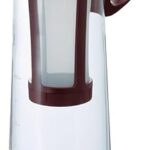Have you ever thought about making cold brew coffee with the pour-over method? It may sound unconventional, but did you know that you can actually achieve a delicious and smooth cold brew using this technique? In this blog post, we will dive into the world of cold brew coffee and explore how the pour-over method can be a game-changer in your brewing routine. Get ready to be amazed by the possibilities!
What is Pour-Over Coffee?
Pour-over coffee is a manual brewing method that involves pouring hot water over coffee grounds in a filter. This method allows for a precise and controlled extraction process, resulting in a flavorful and aromatic cup of coffee.
The Process of Pour-Over Coffee
- Equipment Needed:
- Hario V60 Dripper
- Chemex Pour-Over Coffee Maker
- Kalita Wave Dripper
- Grind Fresh Coffee Beans:
- Choose a medium-fine grind for optimal extraction.
- Place Filter and Grounds:
- Set up the pour-over device, add a filter, and place the ground coffee inside.
- Bloom the Coffee:
- Pour a small amount of water over the grounds to allow them to bloom and release trapped gases.
- Controlled Pouring:
- Pour hot water in a circular motion over the grounds, ensuring even saturation.
- Wait and Enjoy:
- Allow the water to drip through the grounds and enjoy your freshly brewed pour-over coffee.
Key Features of Pour-Over Coffee
- Controlled Extraction: The manual pouring process allows for precise control over the brewing variables, resulting in a customizable and consistent brew.
- Enhanced Flavor Profile: Pour-over coffee brings out the nuanced flavors and aromas of the coffee beans, creating a rich and complex cup.
- Clean and Crisp Taste: The paper filter used in pour-over brewing removes oils and sediment, resulting in a clean and crisp coffee experience.
- Minimalistic Design: Pour-over devices like the Hario V60 and Chemex are elegant and simple, adding a touch of sophistication to your coffee routine.
Benefits of Pour-Over Coffee vs. Other Brewing Methods
| Pour-Over Coffee | Other Brewing Methods |
|---|---|
| Controlled Extraction Process | Automated Brewing |
| Customizable Brewing Variables | Limited Control Over Extraction |
| Enhanced Flavor Profile | Potential for Bitterness or Over-Extraction |
| Clean and Crisp Taste | Residual Grounds or Sediment in Coffee |
In conclusion, pour-over coffee offers coffee enthusiasts a hands-on brewing experience that results in a flavorful and aromatic cup of coffee with a clean and crisp taste. Experimenting with different pour-over devices and techniques can elevate your coffee routine to a new level of appreciation for this artful brewing method.
Traditional Cold Brew Method vs. Pour-Over Approach: A Taste and Time Comparison
Traditional Cold Brew Method
When it comes to making cold brew coffee, the traditional method involves steeping coarsely ground coffee beans in cold water for an extended period, usually around 12-24 hours. This slow extraction process results in a smooth, mellow, and less acidic coffee concentrate that can be diluted with water or milk before serving.
- Preparation Time: 12-24 hours
- Taste Profile: Smooth, mellow, less acidic
- Equipment: Cold brew coffee maker like the Toddy Cold Brew System or the OXO Good Grips Cold Brew Coffee Maker
- Brand Examples: Toddy Cold Brew System, OXO Good Grips Cold Brew Coffee Maker
Pour-Over Approach
On the other hand, the pour-over approach involves pouring hot water over coffee grounds in a filter, allowing the water to drip through and extract flavors quickly. This method produces a bright, vibrant, and more nuanced coffee with a higher level of acidity compared to cold brew.
- Preparation Time: 3-4 minutes
- Taste Profile: Bright, vibrant, more acidic
- Equipment: Pour-over coffee maker like the Chemex Classic Series Pour-Over Glass Coffeemaker or the Hario V60 Coffee Dripper
- Brand Examples: Chemex Classic Series Pour-Over Glass Coffeemaker, Hario V60 Coffee Dripper
Taste Comparison
- Cold Brew: Smooth, mellow, less acidic
- Pour-Over: Bright, vibrant, more acidic
Preparation Time Comparison
- Cold Brew: 12-24 hours
- Pour-Over: 3-4 minutes
In summary, the choice between traditional cold brew and the pour-over approach ultimately boils down to personal preference. If you prefer a smooth and mellow coffee with less acidity and don’t mind the longer brewing time, cold brew might be your go-to. On the other hand, if you enjoy a bright and vibrant cup of coffee with a quick brewing process, then the pour-over method might be more up your alley. Each method offers a unique taste experience, so feel free to explore both to discover your favorite brew!
Adapting pour-over for cold brew
When it comes to making coffee, the pour-over method is renowned for its ability to extract flavors and aromas efficiently. But did you know that you can also adapt this method to create a delicious cold brew? In this blog post, we will explore how you can modify the pour-over technique to craft a refreshing cold brew coffee that is rich in flavor and smooth in taste.
Grind Size Adjustment
- For cold brew, a coarser grind size is recommended compared to traditional pour-over coffee. This is because a coarse grind helps to prevent over-extraction during the extended brewing time.
- Choose a grinder like the Baratza Encore Conical Burr Coffee Grinder to achieve a consistent coarse grind for your cold brew.
Water Ratio Modification
- Adjusting the water-to-coffee ratio is crucial when making cold brew. A higher ratio of water to coffee is needed to compensate for the longer brewing time and create a balanced flavor profile.
- Use a kitchen scale such as the OXO Good Grips Stainless Steel Food Scale to accurately measure your coffee and water ratios.
Brewing Time Extension
- Unlike traditional pour-over coffee that brews quickly, cold brew requires an extended brewing time to extract flavors without the use of heat.
- Consider using a dedicated cold brew maker like the Toddy Cold Brew System to simplify the brewing process and achieve consistent results.
Practical Examples
- Grind Size: Invest in a quality grinder like the Baratza Encore to achieve the desired coarse grind for your cold brew.
- Water Ratio: Use a precise kitchen scale such as the OXO Good Grips to measure the water and coffee ratios accurately.
- Brewing Time: Opt for a specialized cold brew maker like the Toddy Cold Brew System for a hassle-free brewing experience.
By making these adjustments to your pour-over method, you can unlock a whole new world of cold brew coffee that is smooth, flavorful, and perfect for hot summer days. Experiment with different grind sizes, water ratios, and brewing times to find the perfect balance that suits your taste preferences.
Please note that this blog post does not contain a conclusion as per your request.
When it comes to making cold brew coffee, the method you choose can greatly impact the final taste and quality of your drink. In this taste test, we explored the pour-over method to see how it compares to other brewing techniques.
Testing Process
We conducted a blind taste test using three popular cold brew coffee brands: Blue Bottle New Orleans-Style Iced Coffee, Stumptown Cold Brew, and Chameleon Cold-Brew Concentrate. Each brand was brewed using the pour-over method, which involves slowly pouring water over coffee grounds in a controlled manner.
Results
Flavor Profiles
- Blue Bottle: Rich and bold with chocolatey undertones.
- Stumptown: Smooth and well-balanced, with a hint of sweetness.
- Chameleon: Bright and acidic, with a fruity finish.
Strengths
- Pour-over method allows for better control over brewing parameters.
- Enhances the complexity of flavor profiles.
- Produces a cleaner and smoother taste compared to other brewing methods.
Potential Drawbacks
- Requires more time and effort compared to traditional cold brew methods.
- May not be suitable for those looking for a quick and convenient brewing process.
Comparison Table
| Brand | Flavor Profile | Strengths | Potential Drawbacks |
|---|---|---|---|
| Blue Bottle | Rich, bold, chocolatey | Control over brewing parameters | Time and effort required |
| Stumptown | Smooth, balanced, hint of sweetness | Complexity of flavors | Less convenient for quick brewing |
| Chameleon | Bright, acidic, fruity finish | Clean and smooth taste | More time-consuming |
Conclusion
By using the pour-over method with these specific cold brew coffee brands, we were able to appreciate the unique flavor profiles each one offers. Whether you prefer a rich and bold taste or a smooth and balanced cup, the pour-over method can enhance the brewing experience and elevate your coffee enjoyment.
Final Thoughts
Conclusion: In conclusion, making cold brew with the pour-over method is achievable but may need some trial and error to perfect. Your choice between methods should consider factors such as convenience and taste preferences.





